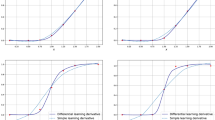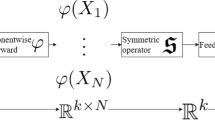Abstract
We propose a numerical method for solving high dimensional fully nonlinear partial differential equations (PDEs). Our algorithm estimates simultaneously by backward time induction the solution and its gradient by multi-layer neural networks, while the Hessian is approximated by automatic differentiation of the gradient at previous step. This methodology extends to the fully nonlinear case the approach recently proposed in Huré et al. (Math Comput 89(324):1547–1579, 2020) for semi-linear PDEs. Numerical tests illustrate the performance and accuracy of our method on several examples in high dimension with non-linearity on the Hessian term including a linear quadratic control problem with control on the diffusion coefficient, Monge-Ampère equation and Hamilton–Jacobi–Bellman equation in portfolio optimization.















Similar content being viewed by others
References
Al-Aradi, A. et al. “Solving Nonlinear and High-Dimensional Partial Differential Equations via Deep Learning”. In: arXiv:1811.08782 (2018)
Abadi, M. et al. TensorFlow: Large-Scale Machine Learning on Heterogeneous Systems. Software available from tensor ow.org. 2015. https://www.tensorflow.org/
Beck, C. et al. “Deep splitting method for parabolic PDEs”. In: arXiv:1907.03452 (2019)
Beck, C., E, W., Jentzen, A.: “Machine learning approximation algorithms for high- dimensional fully nonlinear partial differential equations and second-order backward stochastic differential equations”. In: J. Nonlinear Sci. 29.4 (2019), pp. 1563–1619
Cheridito, P., et al.: Second-order backward stochastic differential equations and fully nonlinear parabolic PDEs. Commun. Pure Appl. Math. 60(7), 1081–1110 (2007)
Chan-Wai-Nam, Quentin, Mikael, Joseph, Warin, Xavier: Machine learning for semi linear PDEs. J. Sci. Comput. 79(3), 1667–1712 (2019)
Darbon, J., Langlois, G., Meng, T.: “Overcoming the curse of dimensionality for some Hamilton–Jacobi partial differential equations via neural network architectures”. In: Res Math Sci 7 (2020)
E, W., Han, J., Jentzen, A.: “Deep learning-based numerical methods for high-dimensional parabolic partial differential equations and backward stochastic differential equations”. In: Com- munications in Mathematics and Statistics 5.4 (2017), pp. 349–380
Fahim, A., Touzi, N., Warin, X.: “A probabilistic numerical method for fully nonlinear parabolic PDEs”. In: The Annals of Applied Probability (2011), pp. 1322–1364
Han, J., Jentzen, A., E, W., : Solving high-dimensional partial differential equations using deep learning. Proc Natl Acad Sci USA 115(34), 8505–8510 (2018)
Huré, Côme, Pham, Huyên, Warin, Xavier: Deep backward schemes for high-dimensional nonlinear PDEs. Math Comput 89(324), 1547–1579 (2020)
Hutzenthaler, M. et al. “Overcoming the curse of dimensionality in the numerical approximation of semilinear parabolic partial differential equations”. In: arXiv:1807.01212 (2018)
Kingma, D.P., Ba, J.: Adam: A Method for Stochastic Optimization. Published as a conference paper at the 3rd International Conference for Learning Representations, San Diego, 2015. 2014. arXiv:1412.6980
Nüsken, N., Richter, L.: “Solving high-dimensional Hamilton-Jacobi-Bellman PDEs using neural networks: perspectives from the theory of controlled diffusions and measures on path space”. In: arXiv:2005.05409 (2020)
Pham, H.: Continuous-time Stochastic Control and Optimization with Financial Applications, vol. 61. Springer, SMAP, Berlin (2009)
Pinkus, A.: “Approximation theory of the MLP model in neural networks”. In: Acta numerica 8 (1999), pp. 143–195. 20
Pardoux, E., Peng, S.: Adapted solution of a backward stochastic differential equation. Syst. Control Lett. 14(1), 55–61 (1990)
Sirignano, J., Spiliopoulos, K.: DGM: a deep learning algorithm for solving partial differential equations. J. Comput. Phys. 375, 1339–1364 (2018)
Schöbel, R., Zhu, J.: Stochastic volatility with an Ornstein-Uhlenbeck process and extension. Rev. Finance 3(1), 23–46 (1999)
Tan, X.: “A splitting method for fully nonlinear degenerate parabolic PDEs”. In: Electronic Journal of Probability 18 (2013)
Sabate Vidales, M., Siska, D., Szpruch, L.: “Unbiased deep solvers for parametric PDEs”. In: arXiv:1810.05094v2 (2018)
Warin, X.: “Monte Carlo for high-dimensional degenerated Semi Linear and Full Non Linear PDEs”. In: arXiv:1805.05078 (2018)
Zariphopoulou, T.: A solution approach to valuation with unhedgeable risks. Finance Stochastics 5, 61–82 (2001)
Author information
Authors and Affiliations
Corresponding author
Additional information
This work is supported by FiME, Laboratoire de Finance des Marchés de l’Energie, and the ”Finance and Sustainable Development” EDF–CACIB Chair.
This article is part of the topical collection “Deep learning and PDEs” edited by Arnulf Jentzen, Lin Lin, Siddhartha Mishra, and Lexing Ying.
Rights and permissions
About this article
Cite this article
Pham, H., Warin, X. & Germain, M. Neural networks-based backward scheme for fully nonlinear PDEs. SN Partial Differ. Equ. Appl. 2, 16 (2021). https://doi.org/10.1007/s42985-020-00062-8
Received:
Accepted:
Published:
DOI: https://doi.org/10.1007/s42985-020-00062-8




